Sandblasting has been a trusted method for decades. But like every tool, this process is defined by the efficiency of the machine behind it. Many workshops still rely on older models, stubbornly pushing them to do jobs they are not built for.
The truth is simple—clinging to outdated sandblasting equipment slows you down, eats your money, and limits your opportunities. Knowing when and why to upgrade is the secret to staying relevant and ahead in a competitive industry.
Why Sandblasting Equipment Matters More Than Ever
The right machine doesn’t just spray abrasive. It defines how precise, clean, and safe the process can be. Today’s industries want accuracy, consistency, and minimal waste.
That’s why equipment has shifted from bulky, one-speed systems to smarter, customizable ones. These new machines can adjust to media, pressure, and surface needs. They recycle better, waste less, and clean faster. In short, the right equipment isn’t just a tool anymore—it’s your ticket to survival.
Signs It’s Time to Upgrade
So how do you know your machine is holding you back? Watch for these signals:
- Inconsistent Results: Patchy or uneven surfaces mean your setup is falling short.
- Dust Everywhere: Old machines can’t recycle abrasives properly, leading to a dangerous mess.
- Rising Bills: More repairs, more downtime, and wasted abrasive—your money is vanishing.
- Rules and Regulations: Governments are pushing for safer, greener blasting. Old machines can land you in trouble.
- Lost Work: If clients demand eco-friendly blasting and you can’t provide it, you’re losing business quietly.
The Weak Links in Old Sandblasting Cabinets
Here’s where the technical side kicks in. Many sandblasting setups struggle not because of blasting itself, but because of what’s powering or supporting the cabinet.
1. The Air Compressor Trap
A lot of shops run cabinets on single-phase, 220-volt compressors. On paper, these look powerful. In reality, they are limited. Why? This is because single-phase motors generate less cfm (cubic feet per minute), which directly affects cleaning speed.
For example:
- 90 cfm can clean a part in 40 seconds.
- 44 cfm takes 1 minute 20 seconds.
- 22 cfm drags it out to 3.5 minutes.
- 11 cfm? That’s 10 long minutes for the same job.
Stretch that over an 8-hour blasting day, and you’ll see how unwise it is. You’ll spend more time waiting for the compressor to recover than actually blasting.
2. The Pressure Problem
When blasting pressure dips below 100 psi, cleaning speed collapses. The difference between 50 psi and 100 psi isn’t double—it’s four times faster at the higher pressure. So even a big air tank won’t save you if your compressor can’t keep up.
3. The Duty Cycle Slowdown
Smaller compressors come with strict duty cycles. If yours has a 60% duty cycle, you must let it cool for 4 minutes after every 6 minutes of running—or risk voiding your warranty. Imagine cleaning a batch of parts with that handicap. Your pace is doomed.
4. Dust Collectors
Many operators ignore the dust collector until it becomes a nightmare. Low-cfm blowers, limited dust storage, and poor filters mean you’ll be stopping every 10–15 minutes to clean.
Even worse, if you upgrade your compressor for more blasting power, the dust collector may choke. Suddenly, your machine can only run 20 minutes, then 7 minutes, then 2 minutes before visibility drops and dust covers everything.
5. The Abrasive Trap
Some cabinet makers push cheap abrasives—slags, poor-quality beads, limited mesh sizes. They clog dust collectors quickly and recycle poorly. This is because their machines don’t have the separators and reclaim systems needed for higher-quality media. In the long run, it kills your efficiency.
When to Upgrade Sandblasting Equipment
Upgrading isn’t always about age—it’s about demand.
- Expanding into aerospace, marine, or high-end manufacturing? You’ll need precision-grade machines.
- Facing new environmental rules? Old machines won’t pass. Retrofits are a money pit.
- Growing workload? Compressors, dust collectors, and cabinets must grow with you.
When your machine can’t keep pace with your jobs, the upgrade isn’t optional anymore—it’s urgent.
Why Advanced Sandblasting Equipment Is Worth It
So why invest instead of patching up? Because modern machines solve every weak link:
- Efficiency: Use less abrasive, less power, more speed.
- Eco-Friendly: Recycling systems slash waste and dust.
- Automation: Smart controls, pressure sensors, even AI monitoring.
- Client Trust: New gear signals professionalism.
- Future-Proofing: You’re ready for tomorrow’s tougher jobs.
Upgrading is not just changing machines; it’s upgrading your reputation.
The Balance Between Cost and Benefit
Yes, advanced machines cost more. But consider the hidden costs of old ones: wasted media, endless repairs, slower projects, non-compliance fines. Often, not upgrading is more expensive.
Smart shops treat equipment as a profit engine, not an expense. The right upgrade opens doors, speeds up jobs, and keeps waste low.
Looking Forward: Smarter Machines, Greener Blasting
The future is already shaping up:
- IoT-enabled machines.
- Automated abrasive recycling.
- Green blasting media replacing toxic ones.
What once felt like science fiction—machines that think, save, and adapt—is now becoming the norm.
Final Thoughts
Upgrading your sandblasting equipment isn’t about shiny new toys. It’s about staying competitive, staying safe, and staying profitable.
If you’re asking whether it’s time to upgrade, chances are—it already is.
Looking to upgrade your sandblasting equipment without guesswork?
At Kramer Industries, we provide advanced blasting machines, eco-friendly media, and expert guidance to help you make the right move. Upgrade today with Kramer Industries and blast your way into the future.




